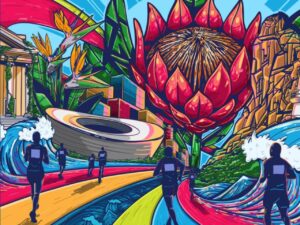[imagesource: Sam Katz / Woody Nitibhon / Henry O’Donnell]
2020’s AfrikaBurn was cancelled due to the pandemic, which is why you weren’t forced to listen to as many lectures about life-changing experiences and like, society, man, last year.
We joke – you Burners do your thing, once it’s safe to do so and all, and 2019’s AfrikaBurn sure looked like a jol.
The original Burning Man, hosted in Nevada’s Black Rock Desert, was also cancelled last year, although there was a virtual party with many of the bells and whistles.
The Black Rock Desert has hosted every Burning Man since 1986, which is founded on 10 basic principles.
Those basic principles won’t change, but organisers are focused on creating something “dramatic, revolutionary, and above all sustainable” on Fly Ranch, an off-grid 3 800-acre ranch in Northern Nevada.
The Burning Man Organisation bought the plot of land in 2016, with the goal to “create a year-round rural incubator for Burning Man culture and a catalyst for innovation and creativity”.
Below via Forbes:
Burning Man Project and the Land Art Generator Initiative collaborated to create the LAGI 2020 Fly Ranch design challenge, inviting innovators and creatives to propose regenerative projects for Fly Ranch…
According to LAGI, “Teams were asked to integrate sustainable systems for energy, water, food, shelter, and waste management into works of art in the landscape.”
This video, posted last year by LAGI, outlines more on the project:
Having considered hundreds of applicants, LAGI has now narrowed its focus to the top 10 designs, some of which are pretty out there.
Ultimately, the goal is to prototype off-grid solutions for a post-carbon world.
Here’s more on some of the top 10 designs:
Nexus [below]… explores the design capabilities of Ferrock, a sustainable alternative to concrete that absorbs CO2 through the curing process of building components…

SEED symbiotic coevolution [pictured right up the top of the page], which incorporates a solar chimney, solar PV, geothermal, passive cooling, composting, greenhouses, aquaponics, biodigesters, and greywater recycling…
Solar Mountain [below], uses solar photovoltaic and recycled materials to contribute 300 MWh of electricity per year and interactive spaces for play and exercise…

Ripple below] integrates electrochromic glass, a bioceramic dome (Geoship SPC), seed bank, solar photovoltaic, cisterns, drip irrigation, composting toilets, and native restoration plants to provide shelter, food, medicinal herbs and teas, habitat enhancement, water harvesting, 36 MWh/year of electricity, and 40,000 liters/year of harvested water.

Some pretty lofty ambitions, but you gotta dream big, right?
According to Elizabeth Monoian, one of LAGI’s founding co-directors, “could it be that when we are capable of designing such systems, we will find inherent beauty emerging from them as well?”
Society, man.
You can read more about the Fly Ranch project here.
[source:forbes]





